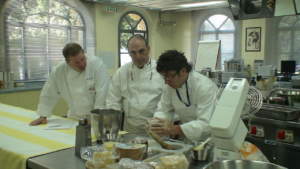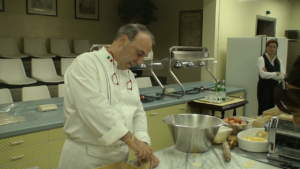 Stefano Cordova is the founder and president of the consulting firm Cordova Food Design, specialized in formulating solutions to food companies by applying “design thinking”, a process of using solutions-based thinking to solving problems. Currently, Stefano serves Chef Innovator of the Bindi’s Group for the United States market. We spoke to Stefano to get his perspective on how he applies global and innovation thinking to food and community.
Stefano Cordova is the founder and president of the consulting firm Cordova Food Design, specialized in formulating solutions to food companies by applying “design thinking”, a process of using solutions-based thinking to solving problems. Currently, Stefano serves Chef Innovator of the Bindi’s Group for the United States market. We spoke to Stefano to get his perspective on how he applies global and innovation thinking to food and community.
What is Design Thinking?
It is a methodology used in social sciences and engineering to solve problems but envisioning the solution and working backwards to completely re-invent approaches to everything from health care to technology to fast-casual dining. At Cordova Food Design, we solve complex catering problems, for example, in local contexts like Italian cities by thinking about the customer first and designing systems around point of service and satisfaction.
In our context, design thinking solves problems but also creates efficiencies for the companies we work with while ensuring the health and satisfaction of customers.
 What is the secret of the current Italian success in America? What do Italian companies operating in the States do better now than before?
What is the secret of the current Italian success in America? What do Italian companies operating in the States do better now than before?
Italian cuisine and companies are flourishing across America. One reason is the continuous demographic shifts, for example the rise in the spending power of Millennials. These individuals have had a major impact on consumer trends and the development of certain retail formats: they demand healthy options like food co-ops and such as health food farmers' markets, and are also more willing to shop for food online than any other generation. Millennials have adventurous tastes and are eager to try new products. However, they also want food that is ethically sourced, the most "green" possible, suitable for snacks, convenient to eat on the road and healthy: Italy offers the best of all this. Heavy Italian cuisine from prior generations has become passé, but has left in its wake an enormous demand for local, high-nutrient and unmodified cheeses, sauces, meats, and grains (from farro as a super food to a re-awakending of semolina-based pastas and reinvention of paleo pastas).
 What are the opportunities you see in terms of products and other new markets?
What are the opportunities you see in terms of products and other new markets?
The upside in the US is unlimited. Italy has made radical changes to its products, and very few have made their way back into the states. For example, ready-to-eat meals served in Italian beachside bars and fast-casual restaurants are healthy and delicious thanks to the application of new production and packaging technologies, and thanks to the ability to introduce new high-level craft references, with relevant bio-different identities (PDOs) that it is not possible to falsify or disguise with similar products.
How has perception changed in America about Italian cuisine and products?
Well, in addition to people’s perceptions having shifted from the 1950s “heavy” concept of Italian cooking, as I mentioned before, you’ve now had generations of American chefs studying in Italy. They’ve really gained a first-hand sense of the essence of not just Italian products and cooking, but also Italian life: And so what you see is a deep appreciation in modern American cooking of Italian ingredients, Italian approach to cooking and community around food, as well as a regionalized knowledge of how good food is made – from parmigiana Reggiano in the north to preparation of Italian meats in Sicily to pizza in Naples. Italian restaurants across Rome, Venice, Milan and Modena and training more and more American chefs, who are returning to American cities with first-hand training and knowledge.
 What role can Italian ready-to-eat play in America?
What role can Italian ready-to-eat play in America?
Italy is perhaps the only country that can reverse the past reputation of the "TV Dinner". I’ve seen some pretty remarkable innovations in Italy, all of which can either be shipped to or replicated in the US. Retort, low temperature cooking, vacuum packaging, cold and high pressure pasteurization, nitrogen cooking, cold smoking. anti-oxidation packaging – creating high-quality, lower-cost and very tasty meals. Italy is the future of innovative fast-casual dining. In addition it is a system that eliminates almost 99% waste, because the processing stations are located in the same cultivation areas. This short supply chain is a great added value for Millennials, but really all of us seeking to either create and serve delicious, healthy hot meals (Italian, of course) or to buy and consume them – or both.
 Can you really replicate good Italian food and products in the States?
Can you really replicate good Italian food and products in the States?
Raw materials matter – and we know Italy has some of the best products and producers in the world. In my opinion, the very best. And, we also know that food producers are the protagonists who design the landscape and culture of the Italy we know today: with olive groves, vineyards, pastures, orange groves ... small fishing boats in beautiful ports. We can replicate these masters in the States, but well-trained chefs and restaurateurs must be the protectors of this culture and these heroes so that we create strong replicas – regionalized perhaps to our towns and cities here in the States. It’s not easy, and a quick visit to a farm will not really help even the most talented American chef replicate the work of a local cheese producer in Italy. Deep study and interest, even passion could help bring the artisan alive in our own context though. Similarly, we can take the best practices of fast-casual food production into the US – but it has to be done well lest we re-create the TV Dinners of the 1950s. And, we can never to forget that what makes the Italian cuisine unique is the combination with superb Italian service hospitality with artistic dedication to every step of the process of creating each raw ingredient and each food item! It’s always a labor of love.
